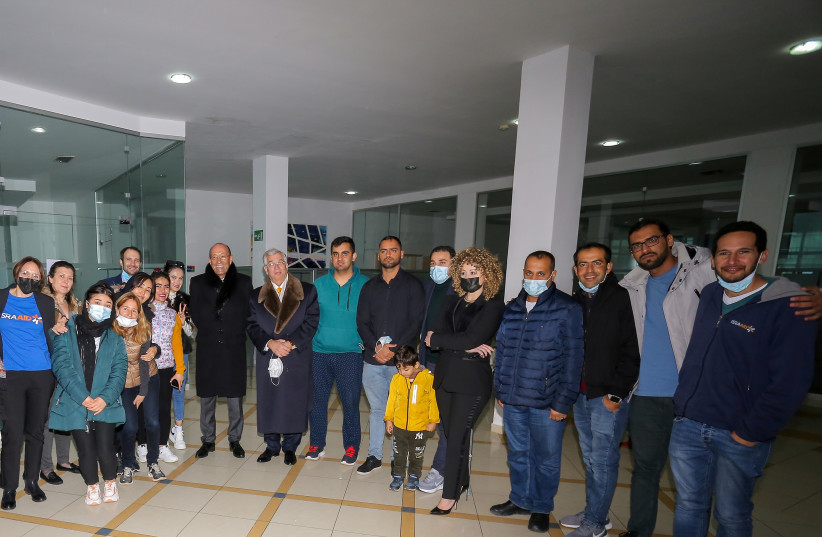Around this time last year, I traveled to Albania as part of my role at IsraAID to meet some of the 167 Afghan refugees that our organization helped evacuate.
There is a plethora of reasons people become refugees, and an infinite number of stories of what people sacrificed when fleeing their country. “J.” was a parliamentary aid to a prominent family, “G.” was a female police officer in a district where it is rare to find female leaders, and “R.” was a male journalist who ran a women’s news network.
What did these people have in common before the Taliban entered Kabul last August?
Possibly not much at all. But after the Taliban took control of Afghanistan, they became part of a newly forged community, created by the necessity to leave Afghanistan and find temporary shelter in Albania, secretly and safely.
It wasn’t obvious that I would connect with this group of people. Raised in Scotland, but now living in Israel, I’ve been privileged to live where I want without fear of violence. Unlike the refugees I met in Albania, moving to a different country was a positive decision, and I had many months to prepare.

Yet I was drawn into this forged community. We may not have the same lived experiences, but what we do have in common is the belief that everyone deserves to live in safety, with the dignity and respect that affords them freedom in their determining their own future.
We ate meals together, shared stories of our families and our education, and I was shown around the “resort” where they were staying. No matter how different the term “holiday resort” may sound from “refugee camp,” that’s exactly what it is. An off-season Albanian holiday resort on the Adriatic coast that houses refugees.
Staying there were hundreds of people who escaped Afghanistan. That’s hundreds of people living in small apartments, with sufficient access to toilets, showers and safe drinking water, and in Albania for less than a year as their visa requests for a more permanent settlement elsewhere were processed.
I had built a picture in my head of what a refugee camp looks like. It’s probably similar to the images most people have, of tent cities, of limited access to water and hygiene facilities, and of families and communities that have lived there for years, perhaps even decades. This is what the media like to tell us, because it captures our attention, but also, because it’s often the truth.
Each refugee crisis is, of course, unique. No one story is the same, and no one refugee settlement is like another, but what connects these people together is one of the toughest decisions a person can make: leaving their homes and communities for fear of their lives.
Some find safety in a neighboring country and some on the other side of the world; some live in decades-old tent cities and others in off-season holiday resorts.
Call them refugee camps or settlements, or even a resort, it doesn’t really matter. What matters is the services that these people are receiving. Across the world, IsraAID is working with refugees and internally displaced persons to provide some of the many essential services required in established refugee communities, one of which is psychosocial support.
The infrastructure in Albania and life beyond
In Albania, as in many of our other countries, we established safe spaces for children, women and men to deal with their trauma, of the initial challenges in their home communities or those they later face as they establish new lives.
This is not a top-down approach. This is listening to the community’s needs and letting them tell us what they need, most often employing specialists from the community itself.
A year out from the Taliban takeover, most of the Afghans IsraAID helped evacuate have been resettled, primarily in Canada, and just a few families remain in Albania awaiting visas. In June, we were able to send medical supplies to victims of the earthquake in Afghanistan, reminding us that the crisis in the country is ongoing. We continue to respond to refugee crises around the world, and sadly, the numbers of refugees and internally displaced people are only rising.
We are working on the front lines of the Ukraine crisis, aiding refugees in Moldova, sending essential aid into Ukraine through the Tulcea Humanitarian Logistics Hub in Romania, and partnering with Ukraine’s first lady to provide essential mental health support for key community members in Odesa and Kyiv.
With our existing teams in the Horn of Africa, we are responding to the unprecedented drought in the region. Right now, we are supporting and strengthening vulnerable populations in 16 countries around the world.
In my role at IsraAID, I learn of refugees’ stories every day. It never gets old. The limitless strength and resilience people have amazes me. No matter from where people flee and where they eventually settle, be it temporarily or permanently, “refugee” describes just a small part of them.
Each of these people has a name, a profession, a family and their own lived experience. And most importantly, their stories are far from over.
The writer is digital communications & content officer at IsraAID.
